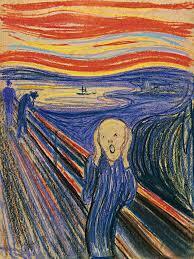
Are artists more likely to suffer from mental illness, or should we say art helped them overcome and live with mental illness? I would argue it is the latter. Artists have created great art, and it helped save them whilst they were creating, albeit for a short while.
“My sufferings are part of myself and my art” – Edvard Munch
Scream by Edvard Munch is a personification of his feelings of desperation. His brush strokes and colors depicted his state of mind. Scream is something we all feel at some point in our life, hence the longevity and popularity of this painting.

The Scream by Edvard Munch
Francisco Goya’s Black Paintings – a series of dark and disturbing paintings done directly on the walls of his new apartment – were developed during a period when he was almost deaf and was very disturbed by the ravages of war. These paintings were done in black, brown, grey, ochre, gold and even a little white. Perhaps Goya could not come to terms with his state of health and suffered from anxiety of growing old.

The Mystery & Terror by Francisco Goya
Were the psychedelic kittens a coping mechanism for Louis Wain during his hospitalization for schizophrenia? These colorful kittens were a far cry from the cuddly, humorous kittens he painted for his wife, many with cigars and quizzical expressions.

Kaleidoscope Cat by Louis Wain
Paul Cezanne, who suffered from depression, made several noteworthy paintings like The Young Man with The Skull, and a few self-portraits while he was depressed.

Young Man with the skull – Paul Cezanne
Van Gogh suffered from myriad psychiatric problems, clearly depicted in many of his paintings like the Wheatfield with Crows, Starry Night, Barred Window and The Raising of Lazarus.

Wheatfield with Crows by Vincent Van Gogh
“I put my heart and my soul into my work, and lost my mind in the process” – Vincent Van Gogh

The raising of Lazarus by Vincent Van Gogh
Rothko too suffered from depression and eventually committed suicide. The color field paintings, especially Untitled #4 and Untitled depict feelings of sorrow.

Untitled #4 Rothko
Pollock was depressed as well, and his inner turmoil’s are shown in a lot of his paintings, especially No. 32, Blue Poles and The Flame.

#32 by Jackson Pollock
Georgia O’Keefe suffered from anxiety and depression. She went without eating or sleeping for long periods of time.

Dark Abstraction by Georgia O’Keefe
Agnes Martin was schizophrenic and sat on her famous bed staring at the canvas until inspiration came to her and then she would paint. She lived well into her nineties and died at the age of 92 despite her condition.

Friendship by Agnes Martin
“Beauty and perfection are the same, they never occur without happiness.” – Agnes Martin
The question of whether artistic genius is related to mental illness has been debated for some time now. Cesare Lombroso (1836-1909) wrote Genio e Follia (Genius and Madness) in 1894. Benjamin Rush the Father of American psychiatry also thought that mental illness and artistic creativity might be related. However, it is also true that not all mental illness results in artistic creativity.
Perhaps, creating art might help patients cope with mental illness.
An interesting take on the subject of art and mental illness was published by Terry Rustin. Rustin painted his patients’ feelings to understand their pain and isolation better, and called these works of his “outsider art”.
My readings and observations lead me to theorize that art really was a way these artists dealt with their psychiatric ailments, and not that they painted because of the illness. Perhaps this is one of the primary reasons why artists like Agnes Martin, Matisse, Michelangelo and Yayoi Kusama have lived long productive lives despite their bouts with mental/debilitative illness.
Yayoi Kusama’s meditative and repetitive art perhaps gives her reason to get out of bed. Creating art in all probability gives meaning to her life and please take note of the colors she surrounds herself with!
Oh, that red hair!

Yayoi Kusama – Wiki photograph
As always, be curious and create!
Hyacinth
https://www.hyacinthpaulart.com/works
Disclaimer: The photographs used in this blog have been taken from publicly available data and the author takes no credit for it.






